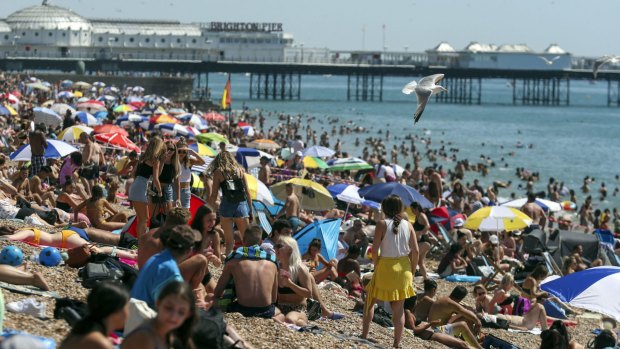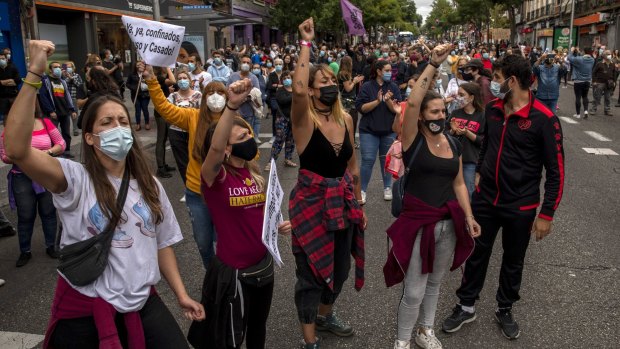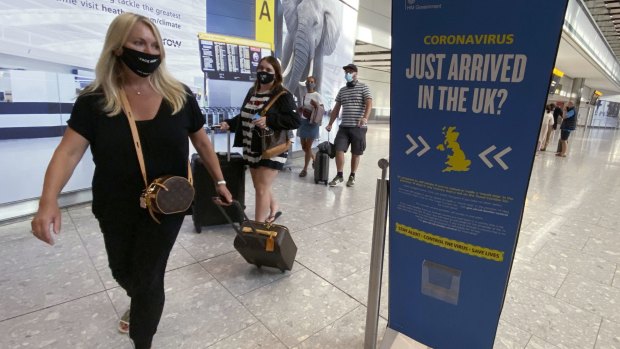This was published 3 years ago
Australia and COVID-19: Four lessons to learn from Europe's summer

People crowd Brighton Beach in England this northern summer, showing scant regard for social distancing rules.Credit: AP
How could they mess up so badly?
In Spain, troops have been deployed to enforce a tough new coronavirus lockdown in parts of Madrid. In England pubs, bars, restaurants and other hospitality venues must now close at 10pm as the coronavirus alert is raised to its second-highest level. Travellers returning to the UK from a holiday in France or Spain must self-quarantine for two weeks. Munich's Oktoberfest, the world's biggest beer festival, has been canned this year.
In June, Europe was on a trajectory to have coronavirus under control. Authorities breathed a sigh of relief, lockdown rules were relaxed, people travelled to their favourite summer holiday spots – and the number of coronavirus infections skyrocketed.

Protesters demonstrate agains lockdown measures in Madrid, Spain. Spain became the first European country to pass 500,000 COVID-19 cases earlier this month.Credit: Getty Images
Travellers bear much of the blame for the soaring number of infections in Europe. That doesn't mean we should all stay on the couch, but we need to look at what Europe has done wrong this summer – and what it has done right. Because the answers to these questions should help shape our own behaviour as summer approaches.
Why is Spain feeling the pain?
On September 8, Spain notched up a new milestone when it became the first European country to record more than half a million coronavirus cases. With infection rates higher than France, the UK and every other European country, coronavirus tests have indicated positive for almost one in 10 of those tested.

Passengers arrive at Heathrow Airport, London. People arriving from COVID-19 hotspots are supposed to self-isolate for 14 days, but less than 20 per cent are doing so.Credit: PA
Government officials have pointed the finger at the country's youth who have been partying, socialising, celebrating with friends and families and disregarding rules around social distancing. Infections spread in the home are believed to be responsible for around 50 per cent of cases.
Spain's response to the crisis has been piecemeal, with much of the fine detail left to regional jurisdictions. Track and trace procedures are neither uniform nor rigorous. When someone tests positive, authorities have difficulty tracing their contacts. Many parts of the country, such as Madrid, where cases have been rising rapidly, have been slow to reimpose lockdown measures such as limiting gatherings to a maximum of 10.
The lesson
The leisure time and conviviality that come with summer holidays are the time when people are most likely to intermingle and ignore social distancing. Effective contact tracing, a single set of coronavirus protocols that applies to a whole country, effective communication and a road map that gives the population a clear picture of what lies ahead are vital.
The changing demographic
The surge in Europe's infection numbers is largely being driven by younger people with the rate increasing most rapidly in the 15-44 age group. In Spain in late March the average age of COVID-19 cases was 59. In mid-September, it's 38. That statistic is mirrored in Ireland, Germany, Spain, the UK and France, which has recorded a 44 per cent rise in the number of infections among those under 14.
The rise was due to younger people ignoring social distancing measures according to UK health minister Matt Hancock. Over the summer holidays popular beach locations along the Mediterranean attracted crowds and social distancing took a holiday. In Spain, many teenagers and young adults gather in the piazzas for the evening botellon, drinking and socialising at close quarters.
On the plus side, the rising number of infections among the young has not been matched by a parallel rise in the COVID-19 mortality rate. Younger people are less likely to die from the virus, and medical facilities are now better able to treat COVID-19 patients. However, anyone infected becomes a transmitter of coronavirus regardless of their age, and that presents a threat to all.
The lesson
Social distancing, masks, testing and contact tracing apply to everyone regardless of age, with harsh penalties for those who break the rules. Spain has launched a social media campaign, #EstoNoEsUnJuego ("This is not a game"), which shows young people partying and ignoring social distancing and not wearing masks, followed by a shot of intensive care patients and finally a coffin borne by mourners.
What Italy got right
Italy was the first European country to be hit hard by the pandemic and the government responded with strict lockdown provisions that closed bars, restaurants and many shops and kept residents in some regions confined to their homes. After peaking in late March, the rate of infections bottomed between June and August before rising in late August to an average of 1200 new cases daily. Between September 1-14, that's an infection rate of 33 per 100,000 of Italy's population and although a cause for concern, it pales beside the figure of 172 new infections per 100,000 in France and 292 in Spain for the same period.
Italy opened its borders to foreign travellers at the beginning of June, well before Spain did the same, but only to those coming from other European countries. In mid-August, Lombardy's health secretary pointed the blame at arrivals from Croatia, Malta, Spain and Greece.
According to Italy's health experts, the country's relative success is due to the country's rigorous lockdown, imposed earlier and for longer than in France and Spain. Italy only relaxed its tight restrictions on September 20 to allow up to 1000 fans to attend sporting events. In France meanwhile, as many as 5000 people per venue are allowed in shows, cinemas and casinos and stadiums have been permitted to host the same number since July 11.
The lesson
Governments wanting to keep the clamp on infection rates should be in no hurry to lift restrictions, especially those governing international travel. Contact tracing is crucial, large gatherings at sporting events and in enclosed spaces are a cause for concern and if you travel, make sure the places you visit have infection rates at least as low as at home.
No airport testing in the UK
Travellers arriving at UK airports from overseas are not tested for COVID-19. However, they are required to quarantine for two weeks unless they are coming from a country or territory on the UK government's exemption list, which currently has more than 50 countries listed, including Australia.
Those who are required to undergo quarantine are allowed to self-isolate, and the UK government's own scientific advisory group has reported that less than 20 per cent comply. Coupled with the lack of airport testing, compliance breaches allow the virus to spread. It's also been established that those who break the self-isolation protocols are unlikely to report those who they might have come into contact with in order to lessen the severity of the breach.
The lesson
Testing of returning travellers is a no-brainer. Provided it's rigorously managed, Australia's response requiring all travellers coming from overseas to quarantine for two weeks under supervision at a hotel is a solid wall (when implemented effectively) that keeps us safe.
Sign up for the Traveller newsletter
The latest travel news, tips and inspiration delivered to your inbox. Sign up now.